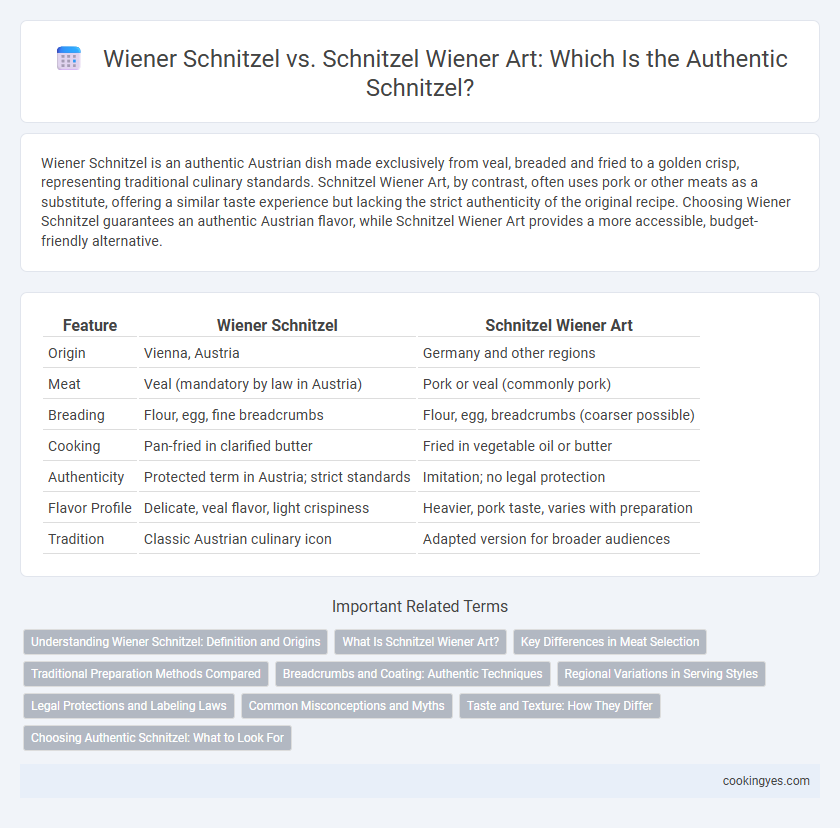Wiener Schnitzel is an authentic Austrian dish made exclusively from veal, breaded and fried to a golden crisp, representing traditional culinary standards. Schnitzel Wiener Art, by contrast, often uses pork or other meats as a substitute, offering a similar taste experience but lacking the strict authenticity of the original recipe. Choosing Wiener Schnitzel guarantees an authentic Austrian flavor, while Schnitzel Wiener Art provides a more accessible, budget-friendly alternative.
Table of Comparison
| Feature | Wiener Schnitzel | Schnitzel Wiener Art |
|---|---|---|
| Origin | Vienna, Austria | Germany and other regions |
| Meat | Veal (mandatory by law in Austria) | Pork or veal (commonly pork) |
| Breading | Flour, egg, fine breadcrumbs | Flour, egg, breadcrumbs (coarser possible) |
| Cooking | Pan-fried in clarified butter | Fried in vegetable oil or butter |
| Authenticity | Protected term in Austria; strict standards | Imitation; no legal protection |
| Flavor Profile | Delicate, veal flavor, light crispiness | Heavier, pork taste, varies with preparation |
| Tradition | Classic Austrian culinary icon | Adapted version for broader audiences |
Understanding Wiener Schnitzel: Definition and Origins
Wiener Schnitzel is an authentic Austrian dish made exclusively from veal, thinly pounded, breaded, and fried to golden perfection, representing a culinary tradition dating back to Vienna. Schnitzel Wiener Art, often made with pork instead of veal, imitates the original's preparation but does not meet the strict criteria that define true Wiener Schnitzel under Austrian food regulations. Understanding the distinction between these two highlights the cultural and culinary significance of Wiener Schnitzel as a protected specialty rooted in Austrian heritage.
What Is Schnitzel Wiener Art?
Schnitzel Wiener Art refers to a breaded and fried pork cutlet prepared in the style of the traditional Wiener Schnitzel, which is originally made from veal and protected by Austrian law as an authentic regional specialty. Unlike the genuine Wiener Schnitzel, Schnitzel Wiener Art uses pork instead of veal but maintains the signature thin, breaded, and crispy texture. This distinction is crucial for authenticity, as only veal cutlets qualify as true Wiener Schnitzel under Austrian culinary standards, while Schnitzel Wiener Art offers a more accessible and affordable alternative maintaining the classic preparation method.
Key Differences in Meat Selection
Wiener Schnitzel is traditionally made from veal, highlighting its authentic Austrian heritage and tender texture. In contrast, Schnitzel Wiener Art typically uses pork, offering a more affordable and widely available alternative. The choice of meat significantly impacts the flavor and authenticity, with veal representing the premium original and pork catering to broader preferences.
Traditional Preparation Methods Compared
Wiener Schnitzel is traditionally made from veal, tenderized, seasoned, and coated in flour, beaten eggs, and breadcrumbs before frying in clarified butter, reflecting authentic Viennese culinary techniques. Schnitzel Wiener Art typically uses pork instead of veal and may include variations in frying methods or breading to reduce costs, deviating from the original recipe. The strict use of veal and specific pan-frying in clarified butter distinguish authentic Wiener Schnitzel from its Schnitzel Wiener Art counterparts.
Breadcrumbs and Coating: Authentic Techniques
Wiener Schnitzel uses finely ground, dry breadcrumbs traditionally made from white bread without crusts, creating a light, crisp coating essential for authenticity. Schnitzel Wiener Art, a variant often made from pork, may use coarser breadcrumbs or mixed types, resulting in a heavier, less delicate crust. Mastery in breadcrumbs and coating technique preserves the Wiener Schnitzel's signature thin, golden crust, differentiating it from less authentic versions.
Regional Variations in Serving Styles
Wiener Schnitzel, made exclusively from veal, represents the authentic Austrian delicacy traditionally served with a lemon wedge and lingonberry jam, emphasizing its precise regional heritage. In contrast, Schnitzel Wiener Art, a more widely adapted version, typically uses pork instead of veal and includes diverse regional variations in breading and accompaniments across Germany and neighboring countries. These serving styles reflect local culinary preferences, distinguishing the original Wiener Schnitzel's strict preparation from the broader, less regulated Schnitzel Wiener Art.
Legal Protections and Labeling Laws
Wiener Schnitzel is legally protected under Austrian and EU law, requiring it to be made exclusively from veal to ensure authenticity, while Schnitzel Wiener Art can be made from pork or other meats without losing its label. The legal protections prevent misuse of the term "Wiener Schnitzel," safeguarding consumers and preserving traditional recipes. Labeling laws mandate clear differentiation, ensuring that only veal-based dishes earn the Wiener Schnitzel designation, reflecting strict adherence to culinary heritage.
Common Misconceptions and Myths
Wiener Schnitzel is an authentic Austrian dish made exclusively from veal, while Schnitzel Wiener Art typically uses pork and is a more affordable variation common outside Austria. A common misconception is that any breaded and fried cutlet called "Wiener Schnitzel" meets the traditional standard, but true Wiener Schnitzel must adhere to strict meat and preparation criteria protected by Austrian food law. Myths often arise from marketing practices that label pork schnitzels as Wiener Schnitzel, confusing consumers about the dish's origin and authentic ingredients.
Taste and Texture: How They Differ
Wiener Schnitzel, made from veal, offers a delicate, tender texture with a subtle, rich flavor, while Schnitzel Wiener Art, typically made from pork, delivers a slightly firmer bite and a more robust taste profile. The authentic Wiener Schnitzel's thin, even breading crisps to a golden perfection, enhancing its lightness, whereas Schnitzel Wiener Art's thicker crust provides a heartier crunch that complements its meatier flavor. Taste and texture distinctions stem primarily from the meat choice and breading technique, crucial for distinguishing genuine Viennese schnitzel from its popular adaptations.
Choosing Authentic Schnitzel: What to Look For
Authentic Wiener Schnitzel is made exclusively from veal, coated in fine breadcrumbs, and fried until golden, reflecting a protected Austrian culinary tradition. Schnitzel Wiener Art often uses pork as a substitute and may include additives, compromising the original texture and flavor. To choose genuine Wiener Schnitzel, verify the meat type, breadcrumb quality, and traditional preparation methods preserving its distinct taste and authenticity.
Wiener Schnitzel vs Schnitzel Wiener Art for authenticity Infographic

 cookingyes.com
cookingyes.com